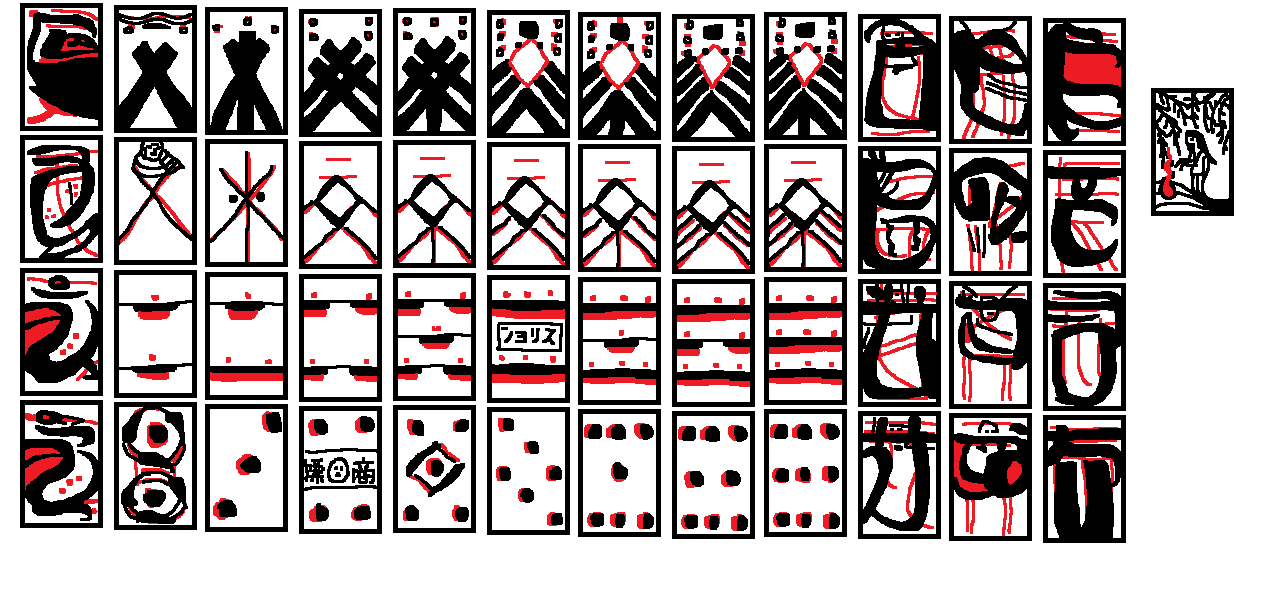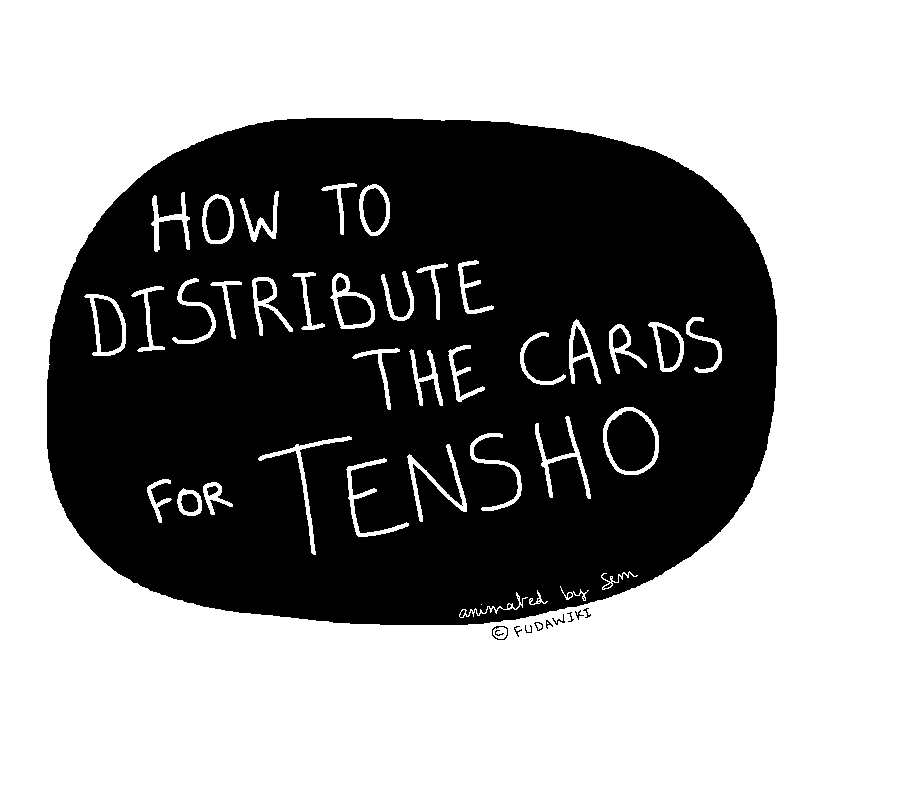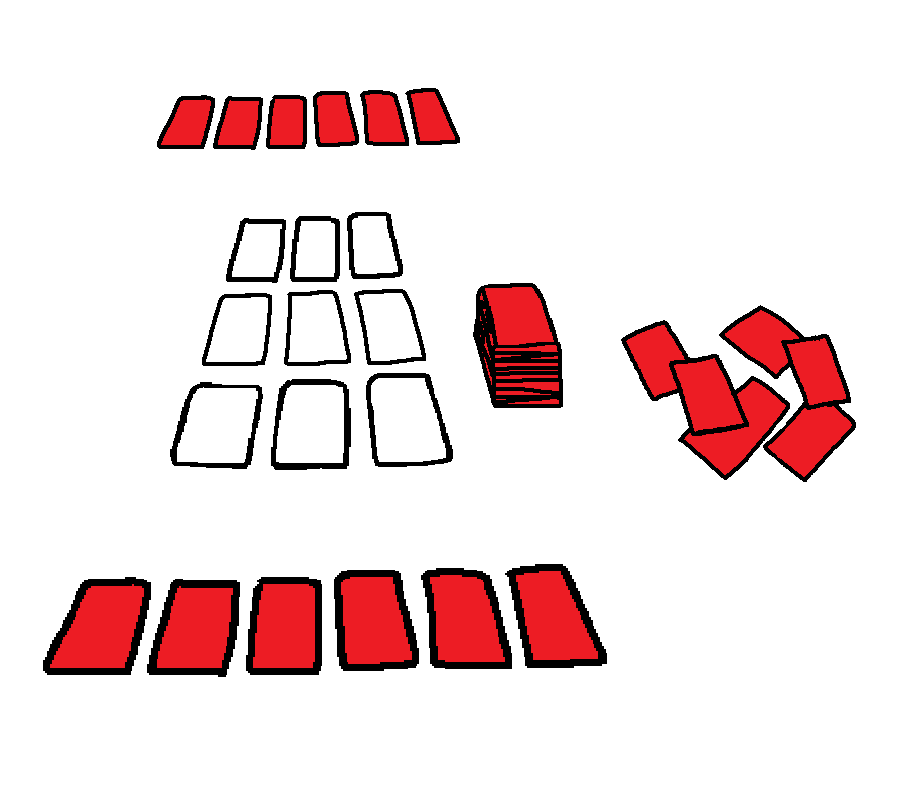Tensho was a mekurifuda game for two players, likely originating in the Nagoya region of Japan.
The game was considered as the predecessor to the games Mekuri and Hana-Awase.
This game was originally played using a mekurifuda deck called Ise. It can also be played using Hanafuda; click here to see the rules using Hanafuda.
The rules written on this page is based on the rules used for hanafuda. It may or may not be the original rules for the game. NEEDS MORE DOCUMENTATION
¶ The Cards

¶ Card Names
| NUMBER | Clubs [Hau/Pao] |
Swords [Isu] |
Coins [Oru/Ouru] |
Cups [Koppu/Kotsu] |
|---|---|---|---|---|
| 1 (Dragon) |
Doro pin | Aka pin (Red 1) |
Gasu pin (Junk 1) |
Gasu pin (Junk 1) |
| 2 | Ao ni (Blue 2) |
Aka ni (Red 2) |
Taiko ni (Drums 2) |
Neburi no ni (Licking of 2) |
| 3 | Ao san (Blue 3) |
Aka san (Red 3) |
Gasu san (Junk 3) |
Gasu san (Junk 3) |
| 4 | Ao shi (Blue 4) |
Aka shi (Red 4) |
Gasu shi (Junk 4) |
Gasu shi (Junk 4) |
| 5 | Ao go (Blue 5) |
Aka go (Red 5) |
Gasu go (Junk 5) |
Gasu go (Junk 5) |
| 6 | Ao roku (Blue 6) |
Aka roku (Red 6) |
Mame roku (Beans 6) |
Gasu roku (Junk 6) |
| 7 | Ao nana (Blue 7) |
Aka nana (Red 7) |
Gasu nana (Junk 7) |
Gasu nana (Junk 7) |
| 8 | Ao hachi (Blue 8) |
Aka hachi (Red 8) |
Gasu hachi (Junk 8) |
Gasu hachi (Junk 8) |
| 9 | Ao kyu (Blue 9) |
Aka kyu (Red 9) |
Gasu kyu (Junk 9) |
Gasu kyu (Junk 9) |
| 10 (Maid) |
Ao jū (Blue 10) |
Surume jū (Cuttlefish 10) |
Gasu jū (Junk 10) |
Gasu jū (Junk 10) |
| 11 (Horse) |
Ao uma (Blue Horse) |
Aka uma (Red Horse) |
Gasu uma (Junk Horse) |
Gasu uma (Junk Horse) |
| 12 (King) |
Ao giri (Blue King) |
Aka giri (Red King) |
Gasu giri (Junk King) |
Gasu giri (Junk King) |
¶ Setup
First, prepare the Ise deck by removing the 6 of swords, 6 of cups, 6 of coins, and the extra “bakefuda” (ghost card), leaving a 45-card deck. Choose the initial dealer in whatever manner preferred. In subsequent rounds, the winner of the previous round becomes the new dealer. Player should also agree on the duration of the game - some common options are 3, 6, or 12 rounds.
¶ Yaku Selection
One unique characteristic of Tensho is that it has two sets of yaku, only one of which is chosen for use each round. This decision should be made prior to the deal, before either player has any information. If the players cannot agree on a set to use, the choice defaults to the dealer’s preference.
¶ Distributing the Cards

The dealer shuffles the deck. There is a specific method of dealing the cards associated with this game:
- Place 3 cards face down next to each other on the field.
- Deal 4 stacks of 3 cards each, face down in the four corners around the field.
- Place another 3 cards face down on the field in a row below the first 3.
- Add another 3 cards to each of the existing stacks in the corners of the field.
- Put 3 final cards face down onto the field in a third row, for a total of 9 cards face down on the field in a 3 by 3 grid.
- Finally, add 3 more cards each to 2 of the stacks in the corners of the field.
- The remaining 6 cards are set aside as “dead cards” this round and will not be used to play Tensho, but may be used to play Tokotoko.
- The dealer chooses one of the stacks of 6 cards to become his hand; the other becomes the opponent’s hand.
- The 2 stacks of 9 cards are combined to become the draw pile for the round.
- Play Shoniban if desired, and reveal the 9 cards on the field.
If this is too convoluted, the important thing is to ensure that each player has a 6-card hand, and that there are 9 cards face up on the field, 6 “dead cards” set aside, and an 18-card draw pile.
Expected result:
¶ Gameplay
Gameplay proceeds in much the same manner as other fishing games, with the dealer playing first. However, if there are 3 cards of the same number on the field at the beginning of the game, the dealer may capture two of those cards, and will instead play second.
On your turn, add one card from your hand to the field, followed by the top card of the draw pile, matching each of them by number with a card on the field if possible. If a pair is made, capture those cards and add them to your scoring area.
Note that since the 6 of clubs is the only card in the deck that has the number 6, the player who plays or draws this card simply places it directly in their own scoring area without first sending it to the field. If the 6 of clubs is dealt to the field at the beginning of the game, neither player can capture it.
Play continues back and forth with each player repeating the above steps in turn, until either one player has collected an instant-win yaku, or both players have run out of cards.
¶ End of Round
The round ends as soon as a player has captured one of the “Instant Win” yaku. Otherwise, players continue taking turns until they have both exhausted their hands, at which point they add up the points for all yaku they have collected. The player who has earned the most points from yaku is declared the winner of the round.
¶ Breaking Ties
If, however, neither player has completed any yaku, or otherwise their yaku scores are the same, then the player who has captured the most Chaff cards wins.
If players are tied with regards to both yaku and number of Chaff captured, each player totals the sum of points for their respective captured cards, according to the Card Values chart below.
¶ Yaku
¶ Both Sets
The first 12 yaku in Tensho are common to both sets of yaku, and thus are always valid. There are two other yaku (Front Elder and Back Elder) that technically fall into this category, but they are listed separately since they change values depending on which yaku set is selected.
| Value | Name of Yaku | Composition |
|---|---|---|
| 100 | Front One Two Three 表一二三 [おもていちにさん, omote ichi-ni-san] |
1 (dragon) of swords, 2 of swords, 3 of swords |
| 50 | Back One Two Three 裏一二三 [うらいちにさん, ura ichi-ni-san] |
1 (dragon) of clubs, 2 of clubs, 3 of clubs |
| 100 | Front One Two Ten 表一二十 [おもていちにじゅう, omote ichi-ni-jū] |
1 (dragon) of swords, 2 of swords, 10 (maid) of swords |
| 50 | Back One Two Ten 裏一二十 [うらいちにじゅう, ura ichi-ni-jū] |
1 (dragon) of clubs, 2 of clubs, 10 (maid) of clubs |
| 100 | Front Three Four Five 表三四五 [おもてさしご, omote sa-shi-go] |
3 of swords, 4 of swords, 5 of swords |
| 50 | Back Three Four Five 裏三四五 [うらさしご, ura sa-shi-go] |
3 of clubs, 4 of clubs, 5 of clubs |
| 100 | Front Nakazō 表ナカゾウ [おもてなかぞう, omote nakazō] |
7 of swords, 8 of swords, 9 of swords |
| 50 | Back Nakazō 裏ナカゾウ [うらなかぞう, ura nakazō] |
7 of clubs, 8 of clubs, 9 of clubs |
| 100 | Front Ten Horse King* 表十馬キリ [おもてじゅううまきり, omote jū-uma-kiri] |
10 (maid) of swords, 11 (horse) of swords, 12 (king) of swords |
| 50 | Back Ten Horse King* 裏十馬キリ [うらじゅううまきり, ura jū-uma-kiri] |
10 (maid) of clubs, 11 (horse) of clubs, 12 (king) of clubs |
| 100 | Front Nine Horse Three 表クマザン [おもてくまざん, omote kumazan] |
9 of swords, 11 (horse) of swords, 3 of swords |
| 50 | Back Nine Horse Three 裏クマザン [うらくまざん, ura kumazan] |
9 of clubs, 11 (horse) of clubs, 3 of clubs |
* Some sources give these yaku as “Ten Nine Twelve” with ‘9’ cards replacing the ‘11’ (horse) cards shown here.
¶ Set 1 Only
Set 1 - 七分役 [しちぶやく, shichi-bu yaku] contains 3 more yaku than Set 2, and emphasizes cards with numbers 11 (horse), 3, and 4, in that order.
| Value | Name of Yaku | Composition |
|---|---|---|
| 100 | Front Seven Five Three 表七五三 [おもてしちごさん, omote shichi-go-san] |
7 of swords, 5 of swords, 3 of swords |
| 50 | Back Seven Five Three 裏七五三 [うらしちごさん, ura shichi-go-san] |
7 of clubs, 5 of clubs, 3 of clubs |
| 100 | Front Eight Islands 表ヤシマ [おもてやしま, omote yashima] |
8 of swords, 4 of swords, 11 (horse) of swords |
| 50 | Back Eight Islands 裏ヤシマ [うらやしま, ura yashima] |
8 of clubs, 4 of clubs, 11 (horse) of clubs |
| 100 | Front Four Horse King 表シマキリ [おもてしまきり, omote shi-ma-kiri] |
4 of swords, 11 (horse) of swords, 12 (king) of swords |
| 50 | Back Four Horse King 裏シマキリ [うらしまきり, ura shi-ma-kiri] |
4 of clubs, 11 (horse) of clubs, 12 (king) of clubs |
| 100 | Front Eight Four King 表ハツシキリ [おもてはっしきり, omote hasshi-kiri] |
8 of swords, 4 of swords, 12 (king) of swords |
| 50 | Back Eight Four King 裏ハツシキリ [うらはっしきり, ura hasshi-kiri] |
8 of clubs, 4 of clubs, 12 (king) of clubs |
| 300 | Front Eight Islands King 表ヤシマキリ [おもてやしまきり, omote yashima-kiri] |
8 of swords, 4 of swords, 11 (horse) of swords, 12 (king) of swords |
| 150 | Back Eight Islands King 裏ヤシマキリ [うらやしまきり, ura yashima-kiri] |
8 of clubs, 4 of clubs, 11 (horse) of clubs, 12 (king) of clubs |
| Instant Win | Front Elder 表御老中 [おもてごろうじゅう, omote gorōjū] |
5 of swords, 6 of clubs, 10 (maid) of swords |
| 100 | Back Elder 裏御老中 [うらごろうじゅう, ura gorōjū] |
5 of clubs, 6 of clubs, 10 (maid) of clubs |
¶ Set 2 Only
Set 2 - 半役 [はんやく, han yaku] has fewer yaku total, but has one more yaku that grants an instant victory. It has many yaku featuring cards of the numbers 10 (maid), followed by 8, and 9.
| Value | Name of Yaku | Composition |
|---|---|---|
| 100 | Front Young Woman 表娘 [おもてむすめ, omote musume] |
7 of swords, 8 of swords, 10 (maid) of swords |
| 50 | Back Young Woman 裏娘 [うらむすめ, ura musume] |
7 of clubs, 8 of clubs, 10 (maid) of clubs |
| 100 | Front Old Woman 表婆さん [おもてばあさん, omote bāsan] |
8 of swords, 9 of swords, 10 (maid) of swords |
| 50 | Back Old Woman 裏婆さん [うらばあさん, ura bāsan] |
8 of clubs, 9 of clubs, 10 (maid) of clubs |
| 300 | Front Women, Young and Old 表娘婆さん [おもてむすめばあさん, omote musume bāsan] |
7 of swords, 8 of swords, 9 of swords, 10 (maid) of swords |
| 150 | Back Women, Young and Old 裏娘婆さん [うらむすめばあさん, ura musume bāsan] |
7 of clubs, 8 of clubs, 9 of clubs, 10 (maid) of clubs |
| 100 | Front Elder 表御老中 [おもてごろうじゅう, omote gorōjū] |
5 of swords, 6 of clubs, 10 (maid) of swords |
| Instant Win | Back Elder 裏御老中 [うらごろうじゅう, ura gorōjū] |
5 of clubs, 6 of clubs, 10 (maid) of clubs |
| Instant Win | Red Four 赤四 [あかし, aka-shi] |
4 of swords, 6 of clubs, 1 (dragon) of clubs |
¶ Card Values
Under most circumstances, only yaku are counted, and card values are not calculated. However, in the case that both players have identical yaku scores and equal numbers of captured Chaff cards, the tie may be broken and the winner determined by the player with the greater sum of points for all captured cards.
The differences between card value tables are marked in bold.
¶ Ise Card Values
| Card Value | Cards |
|---|---|
| 15 | 1 (dragon) of clubs |
| 12 | 12 (king) of clubs |
| 11 | 11 (horse) of clubs |
| 10 | 2 of clubs, 2 of coins, 6 of coins, 10 (maid) of clubs, 10 (maid) of swords |
| 9 | 9 of clubs |
| 8 | 8 of clubs |
| 7 | 7 of clubs |
| 5 | 5 of clubs, 1 (dragon) of swords |
| 4 | 4 of clubs |
| 3 | 3 of clubs |
| 1 | 6 of clubs, All swords except 1 (dragon) and 10 (maid), All coins except 2 and 6, All cups |
¶ Alternative Card Values (Optional)
These values have been taken from the Hanafuda version of the game, where each card in the Mekurifuda deck corresponds to that of the Hanafuda deck in Nagoya month sequence.
| Card Value | Cards |
|---|---|
| 15 | 1 (dragon) of clubs |
| 12 | 12 (king) of clubs |
| 11 | 11 (horse) of clubs |
| 10 | 2 of clubs, 2 of swords, 6 of clubs, 10 (maid) of clubs, 10 (maid) of swords |
| 9 | 9 of clubs |
| 8 | 8 of clubs |
| 7 | 7 of clubs |
| 5 | 5 of clubs, 1 (dragon) of swords |
| 4 | 4 of clubs |
| 3 | 3 of clubs |
| 1 | All swords except 1 (dragon), 2 and 10 (maid), All coins, All cups |
